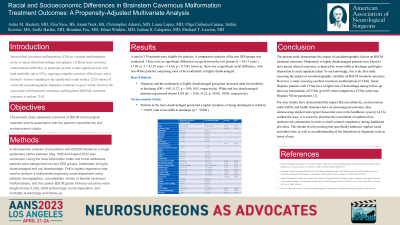Racial and Socioeconomic Differences in Brain Stem Cavernous Malformation Treatment Outcomes
Friday, April 21, 2023


Ashia Hackett, MD
Clinical Research Intern
Barrow Neurological Institute
ePoster Presenter(s)
Introduction: Evidence of racial and sociodemographic disparities continues to grow; however, the association with brainstem cavernous malformation (BSCMs) treatment outcomes is unclear. We sought to analyze the impact of race, socioeconomic status (SES), and insurance coverage on clinical outcomes of patients with BSCMs.
Methods: A retrospective analysis of all patients with BSCMs treated at a single quaternary center between May 1985 and August 2022 was conducted. Using the Area Deprivation Index and home addresses, patients were categorized into two SES groups, moderately-to-highly disadvantaged and low disadvantage. Firth’s logistic regression was used to perform a multivariate propensity score adjustment using patients’ demographics, comorbidities, history of familial cavernous malformations, and the Lawton BSCM grade. Primary outcomes were length-of-stay (LOS), Modified Rankin Score (mRS) at discharge, discharge disposition, and morbidity at discharge and follow-up.
Results: A total of 139 patients were eligible for analysis. A comparative analysis of the two SES groups was conducted. There were no significant differences in age between the two groups (x̄ = 44.13 years ± 17.89 vs. x̄ = 45.39 years ± 14.66, p = 0.724); however, there was a significant racial difference, with non-White patients comprising most of the moderately-to-highly disadvantaged group. Patients in the more disadvantaged group had a higher incidence of being discharged to rehab (p = < 0.001) and worse mRS at discharge (p = < 0.001). Hispanics and the moderately-to-highly disadvantaged group had increased odds for morbidity at discharge (OR = 6.01, 0.27, p = 0.04, 0.03, respectively). White and less disadvantaged patients experienced shorter LOS (β = - 0.46, -0.22, p < 0.001, 0.005, respectively).
Conclusion : We demonstrate the impact of sociodemographic factors on BSCM treatment outcomes, with moderately-to-highly disadvantaged patients having poorer clinical outcomes. Larger cohort studies are necessary to further assess the results herein.
Methods: A retrospective analysis of all patients with BSCMs treated at a single quaternary center between May 1985 and August 2022 was conducted. Using the Area Deprivation Index and home addresses, patients were categorized into two SES groups, moderately-to-highly disadvantaged and low disadvantage. Firth’s logistic regression was used to perform a multivariate propensity score adjustment using patients’ demographics, comorbidities, history of familial cavernous malformations, and the Lawton BSCM grade. Primary outcomes were length-of-stay (LOS), Modified Rankin Score (mRS) at discharge, discharge disposition, and morbidity at discharge and follow-up.
Results: A total of 139 patients were eligible for analysis. A comparative analysis of the two SES groups was conducted. There were no significant differences in age between the two groups (x̄ = 44.13 years ± 17.89 vs. x̄ = 45.39 years ± 14.66, p = 0.724); however, there was a significant racial difference, with non-White patients comprising most of the moderately-to-highly disadvantaged group. Patients in the more disadvantaged group had a higher incidence of being discharged to rehab (p = < 0.001) and worse mRS at discharge (p = < 0.001). Hispanics and the moderately-to-highly disadvantaged group had increased odds for morbidity at discharge (OR = 6.01, 0.27, p = 0.04, 0.03, respectively). White and less disadvantaged patients experienced shorter LOS (β = - 0.46, -0.22, p < 0.001, 0.005, respectively).
Conclusion : We demonstrate the impact of sociodemographic factors on BSCM treatment outcomes, with moderately-to-highly disadvantaged patients having poorer clinical outcomes. Larger cohort studies are necessary to further assess the results herein.
